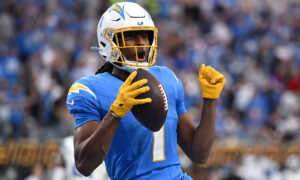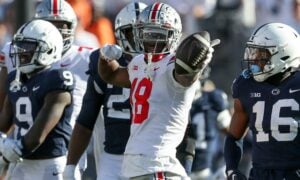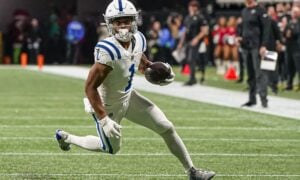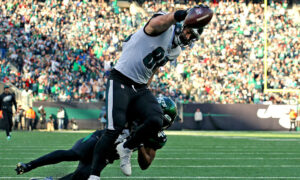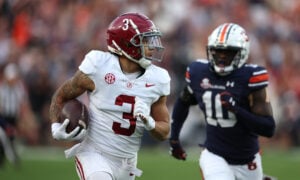The DLF Mailbag
Welcome to the latest edition of the weekly mailbag.
Send me your questions using the DLF Mailbag Form and I’ll include the best in future articles. Remember the guidelines to have the best chance at seeing your question get posted:
1.) Dynasty questions only, no start/sit questions
2.) Help me help you by providing sufficient information about your league (e.g. line-up requirements/PPR or non-PPR/etc.), and include your first name and where you’re from.
Let’s get to it!
1.) Is there any support for the idea of owning the QB and WR (or TE) from the same team? I own both Stafford and Pettigrew. Am I better off starting both of them or trying to trade Pettigrew for another TE in the same range? Is there extra value to be had by having a pairing? – Bret in Nashvegas
No. This is a common misconception. As far as I know, there is no statistical advantage to owning a pair, nor is there a statistical disadvantage. It’s quite simple; you want to own the very best players available to you at each and every position. And forcing yourself to adjust your rankings based on pairings would lead you to draft sub-optimally or value players incorrectly in trade negotiations.
There are owners who want to own the pairs. That might provide an opportunity. Let’s say you own Hakeem Nicks and the another owner has Megatron and Eli Manning. Maybe you can get a cheaper Nicks for Megatron deal if that particular owner subscribes to the theory that pairing a QB and WR is somehow beneficial.
There could be some psychological arguments in favor of (or opposed to) the pairing concept, but statistics wouldn’t support those arguments. It really doesn’t matter – just get a hold of the best players you can and ignore this artifact.
2.) What do you look at to determine how long to keep a RB? I have Arian Foster, Ray Rice, CJ2K and Jonathan Stewart and I’m trying to figure out which one is closest to being done so I can trade him at the highest point? I don’t want to sell prematurely and miss out on production, either. – Jason in Madison, WI
I am 100% about value and view all my dynasty players as assets. No player on my team is off limits for trades. And I tend to be the instigator of most deals. So I’m looking to churn my roster at all times. And running back is an area of primary focus because the shelf life is so short.
The first thing I consider is the overall condition of my team. If I have an aging running back and know that I am a competing team, I’ll probably ride him until all the gas is out of the tank. I think guys like Michael Turner and Frank Gore are grossly undervalued relative to my projected 2012 fantasy numbers. I’m okay in that situation to get “left holding the bag.” The game is about winning championships, not looking smart in trades.
The second thing I do is make the trades in season, not in the off-season. During the off-season, owners are overthinking things like age, health, etc. During the season, they are more focused on short term production – that’s the time to deal a productive, yet aging back. Plus, during the season you have a better perspective on your team’s relative strength to the rest of the league.
I’m heavily stats driven so I also watch the yards per carry from year to year. If I’m seeing a decline, I’m likely to start shopping my player. Also, I’m less concerned about total touches than I am about age. Age is the bane of running backs.
3.) What’s the outlook for Kendall Hunter? I’m desperate at running back, but the Brandon Jacobs signing worries me. Should I hold Hunter or try to move him to the Gore owner as a handcuff? By the way, you guys are dealing out the analysis while the other fantasy writers are hibernating. – John in Chicago
First off, thank you for the compliment. As you know, our motto is “There is No Off-Season!” Hopefully you enjoyed the extensive draft coverage this past weekend.
Now as to your question about Hunter’s prospects:
They aren’t good. The running back situation in San Francisco seemed relatively clear until the draft. Now, I’m not sure what to think. LaMichael James is a real talent. And that selection was one of the more surprising ones to me.
The time to move Hunter was a week ago to the Gore owner. As you say, he appeared to be a very solid handcuff for a guy who has a, somewhat undeserved, injury reputation. Now the Gore owner is likely unsure who the handcuff is or what Hunter’s role might be.
My expectation is that dynasty owners will severely discount Hunter at this point. Hunter’s ADP was as a midlevel RB3 prior to the NFL draft. I think this will plummet to RB5 or worse at this point. Unfortunately, I don’t see you getting anywhere near decent value for Hunter. I’d recommend holding until the situation becomes less murky.
You have nothing to lose at this point.
4.) My team is stacked I’ll admit it, but I still want to improve via trades. I am one running back short of having a tremendous run, but no one will touch me in a trade. I can’t even get a bad deal. Advice? – David, also in Chicago
I’ve seen this happen in one of my leagues recently. A team is clearly superior and other owners are leery of trading with them. Worse yet, when teams do trade with the powerhouse the message board lights up with criticisms.
I’m not sure there’s an easy answer to your question. Sounds like you are a victim of your own success!
I’d recommend the following:
- People find it irritating when stronger teams trade purely from their bench depth. You may have to pony up a quality player in order to get a deal done.
- Consider trading for older players who can still push you over the top. There are aging running backs out there that could take a serious contender to a league championship. There isn’t much use in a team in a rebuild to hold on to Fred Jackson, Michael Turner, Frank Gore, etc. Maybe you target this type of back.
- Consider taking some garbage along with the stud you are looking for. Just dumping a player can make an owner feel good about a deal.
- Be prepared to deal picks. Sometimes the most enticing thing you can offer is a future pick. Of course, the strength of your team works against you here.
- If your league allows conditional trades, then consider that. For example, you could offer a 2013 second round pick for Turner and if he exceeds 1,200 yards, it becomes a 2013 first round selection. Now the other owner is rooting for your success – that Could serve to take the edge off of dealing with the league leader
Good luck and the waiver wire is always there for you to round out the last pieces of your dynasty juggernaut.
Editor’s Note: Tim Stafford can be found @dynastytim on twitter and in the forums as tstafford.







